YOUR CART
- No products in the cart.
Subtotal:
$0.00

Award winning American textile artist Deborah Boschert uses art quilt collage as a medium to tell stories. Her work features recurring symbols, shapes and motifs that explore her personal experiences.
However, these also reflect universal themes of what it means to be human – what is important to us and how we interact with our experience, each other and the world around us. She loves that the stories she creates through her work are often interpreted very differently by the viewer. That is the power of art and the potential conversations it can generate.
Pausing, looking and self reflecting are intentional parts of her creative process, and allow her to balance the essential components of a piece – colour, composition, style and personal voice – as she assesses what works and what doesn’t.
Deborah also reveals a willingness to let go and embrace the messiness of the creative process – the highs and lows – to encourage a spontaneity that can seem at odds with the slow, intentional nature of stitch.
Deborah shares her system of tapping into emotions to discover the ideas that excite her, and the importance of developing and mastering the technical skills to bring her vision to fruition.
Deborah Boschert: Some people create because it’s who they are. I create to understand who I am. I’m an artist, author and teacher creating art quilt collages with layers of fabric, paint and stitch. I often incorporate personal symbols in my work. They may represent ideas and experiences that have influenced my life.
For me, the creative process gives me an opportunity to have a conversation with myself.
People often say it’s important to understand your ‘why’. Why am I creating? What am I seeking? What experience do I want to have? My biggest challenge is figuring out the answers to these questions and then prioritising those ideas. It’s easy to get distracted by opportunities that could pull me away from my real reasons for creating. It’s okay that the reasons sometimes change, but I try to balance both focus and flexibility.
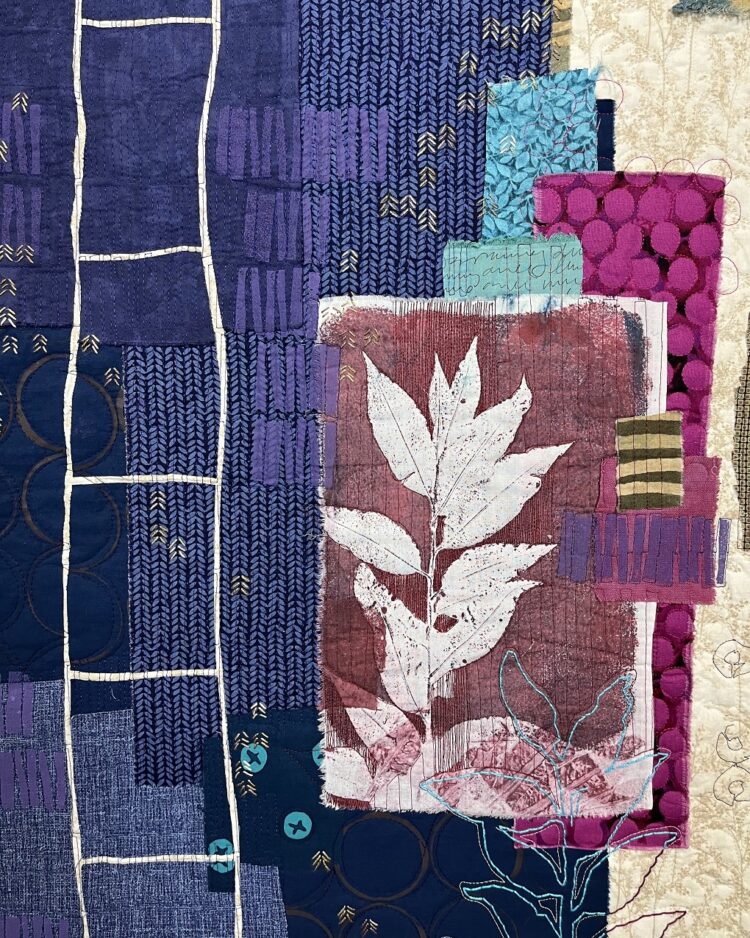
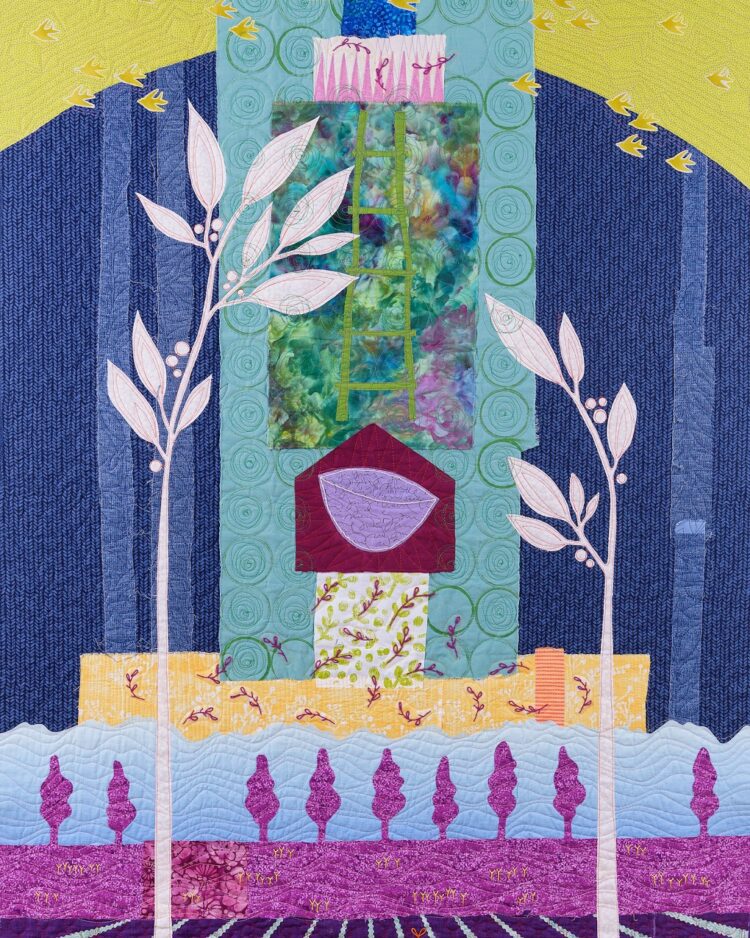
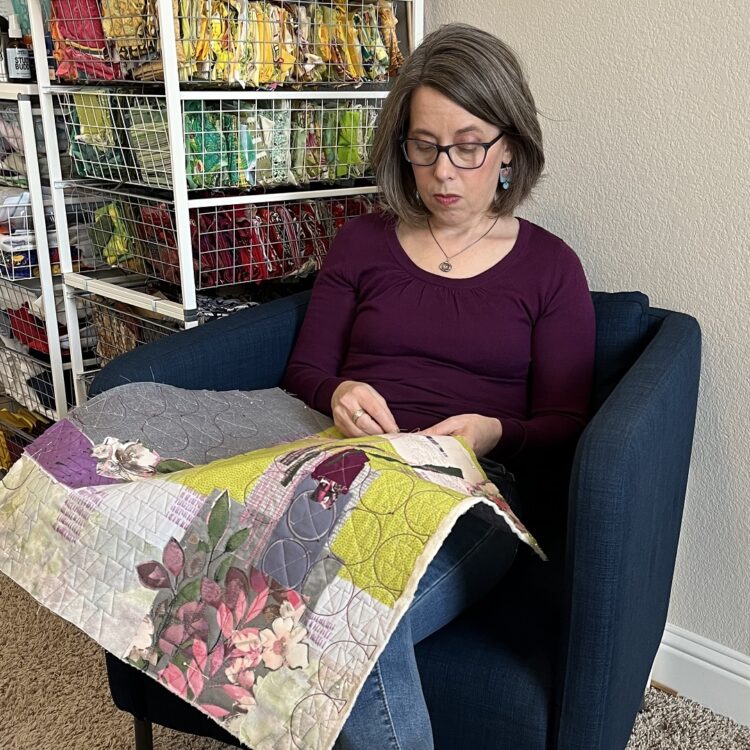
I’m inspired by something new every day but currently, I’m thinking about abstract compositions and layering more fabric on fabric, stitching on stitching, stitching on fabric, paint on fabric, stitching on paint, and every possible combination to create dynamic designs.
I’m also exploring beautiful, energetic, unpredictable lines that can be created with paint and a brush, and how I might get that same kind of energy with fabric and stitch.
I love abstract paintings and I have been thinking about how I can emulate the spontaneity of a brush stroke with fabric and stitching. It’s tricky because stitching a line (with machine or by hand) is inherently slow and intentional. Exploring ways to loosen up my process is an interesting challenge.
A favourite recent piece is Uncultivated. It’s part of a series where I am exploring more abstract compositions. There are many more layers of stitching and I’m switching up the order of my creative process, which allows me to add more surface design and texture as the piece progresses.
In coming up with a title for this piece, I wanted something that nodded to the idea of growth but also acknowledged the messiness of the creative process — and of life in general. Making change can be difficult and I feel like this piece is a bit out of the norm when thinking about most art quilts. But what is the norm anyway? The word ‘uncultivated’ is reminiscent of a weedy garden, but sometimes that’s where we discover unexpected delight and beauty.
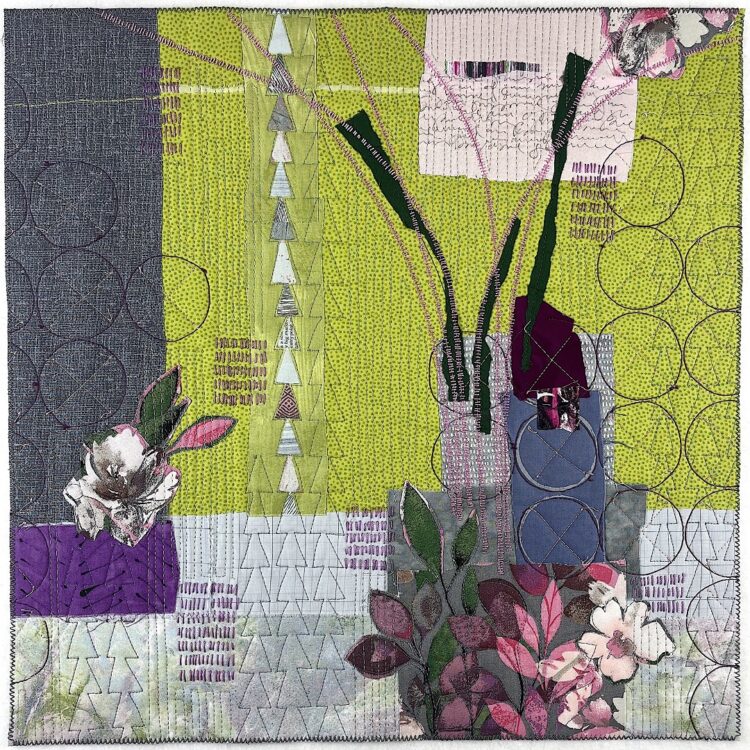
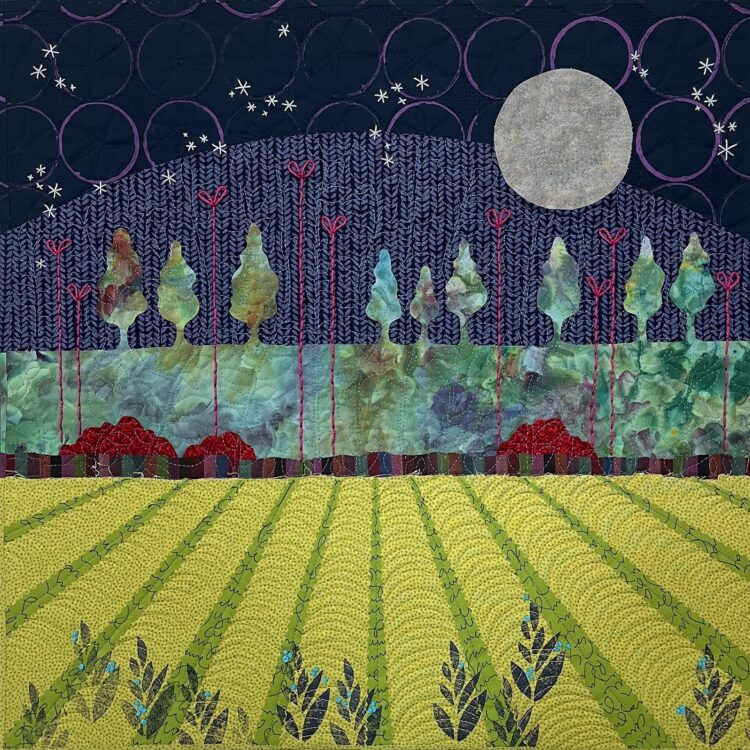
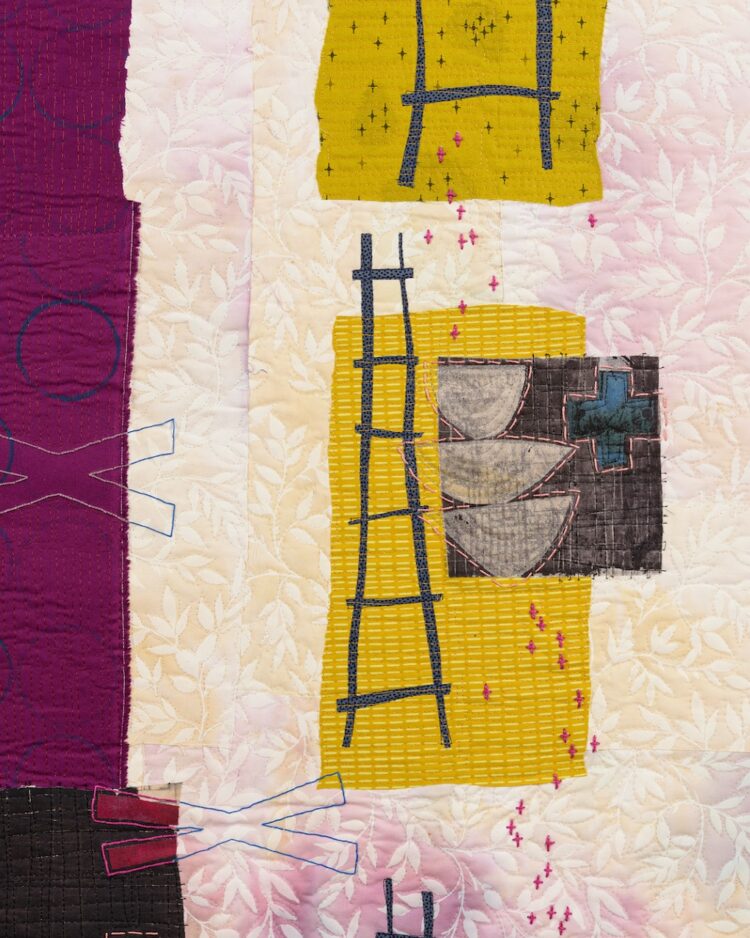
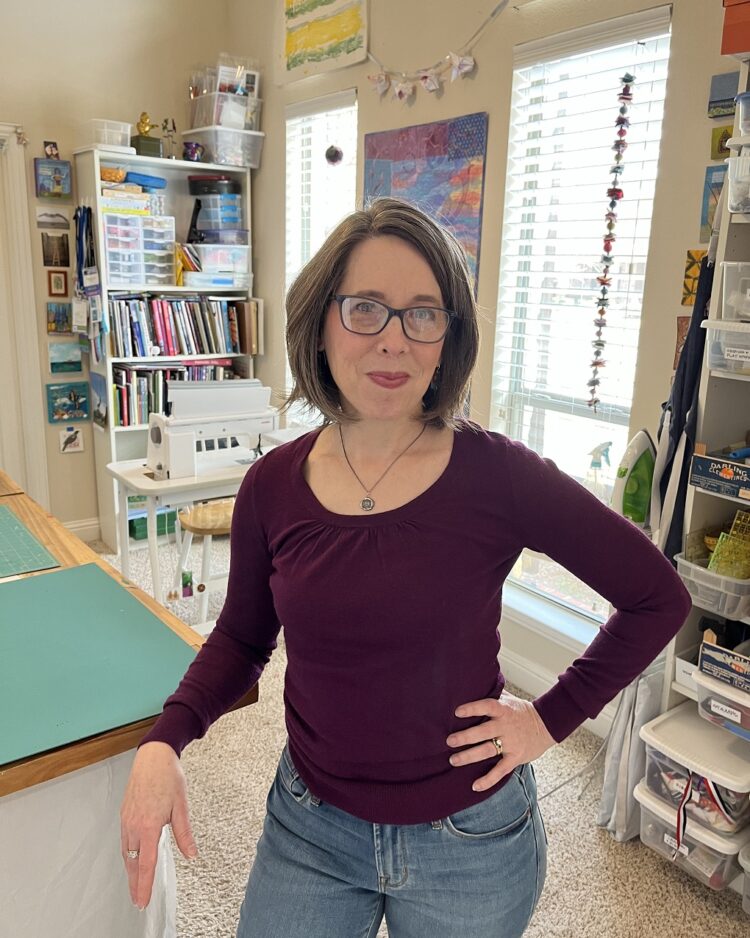
I love the momentum of the whole creative process and moving from one stage to the next until a piece finds its way to completion. However, it’s not always easy or predictable. Sometimes the process is slow, arduous and unclear. Other times I’m excited and motivated as I’m gathering a palette of fabrics to work with, but then I agonise over what to do with them. Sometimes I have a composition in mind but struggle with colour and mood. Or the first layers of the collage come together quickly but additional layers of paint and stitching take forever.
I have become familiar and comfortable with the unpredictable pace of the creative process which (usually) helps me stay motivated and persist through the ‘ugly’ stages. I believe the most important thing is to create regularly and to take time to reflect on the process and the results.
I spend a lot of time standing in front of my design wall just looking. I also study art made by a wide variety of artists and think about how I might use similar colours, compositions and subject matter in my own way.
Self critique as part of the creative process is a matter of auditioning possibilities, editing and giving myself time and space to make decisions. But not too much time – I also try to remember there isn’t any real right or wrong. I’d rather make more work that is good or even great than spend too much time agonising over trying to make a few pieces that are fantastic.
I love sharing my work and I’m eager for others to have their own experiences and ideas about my art quilt collages. I try to remember that the same piece of art that I may over critique, over work and agonise over, may be the same piece that a viewer really connects with in a positive way.
Some people say in order to develop your voice, you just have to make a lot of work, but I think it’s more than that.
For me, it’s about finding clarity in the ideas I want to explore, joy in the process and mastery of the required skills. I try to maximise what’s going on in my head, heart and hands in order to create my best, most personal and unique work.
I think about the ideas and themes I want to explore – that’s the head part. I zero in on what makes me excited and motivated about the materials, process and other aspects of the whole process – that’s the heart element. And I refine, practice, study and master the techniques that will help me achieve my vision – that’s the hands part.
As I’ve become clearer and more confident in the materials and techniques I use, my work is more confident and has greater clarity. It all goes together.
There are many ideas I’m eager to explore. I want to make more dense abstract work in both large and small formats. I will definitely make more contemporary graphic fabric landscapes. I’m working on some three-dimensional structures. I’d like to build a concept collection that would make an interesting exhibition. It’s a challenge to focus time and energy on so many possibilities while keeping the work cohesive and making space for experimentation.
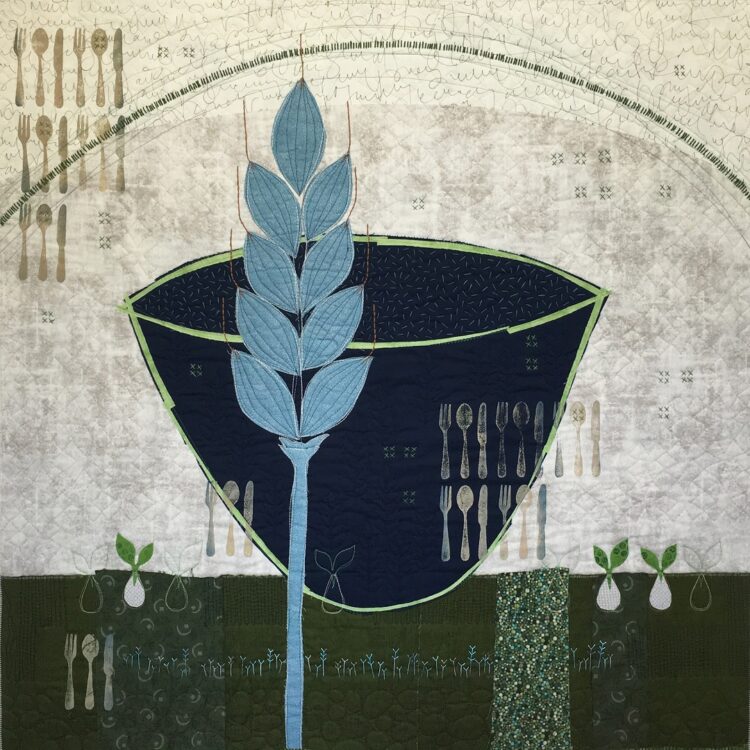
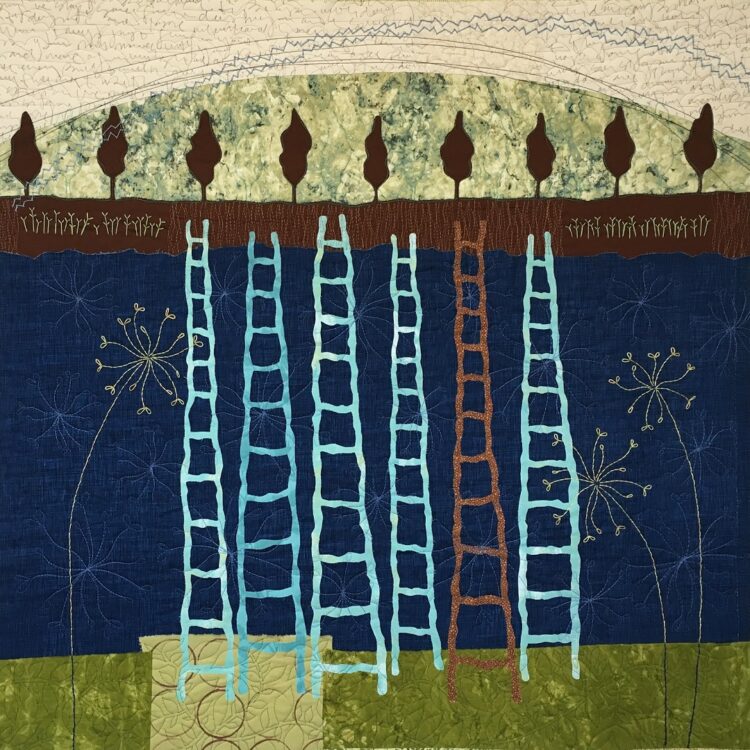
I always come back to the idea that a simple shape, set in an interesting composition and embellished with other marks, stitches, and patterns can help me tell a story about my life.
I love returning to shapes, symbols, marks and motifs over and over. When I start a new piece, the seed of inspiration could take many different forms but, as the piece develops, I am always thinking about how I will incorporate elements that I’ve used in other pieces. That may be a pattern printed with an original foam stamp, or a smattering of hand embroidered ‘Y’ stitches, or an arch at the top of the composition.
When I first began making art quilts of my own design, I made lots of house quilts. At that time, my husband and I were moving every two or three years for his military career. First, I love the very simple five-sided shape that is clearly a house. But I also realised the way the houses in my quilts seemed to float in some undefined space between foreground and background could represent my unsettled feelings about all those moves. Still, there were also things I loved about moving and living in different places. So those positive elements were represented with colour, motifs and other contemporary embellishments.
The chairs in my work are a reminder to myself that being still and restful does not mean being inactive or unaware. Sometimes it’s essential to sit quietly and take in everything around me. They represent the importance of thought, reflection and patience.
I often incorporate ladders into my art quilt collages. I became enamoured with the ladder shape when I saw Martin Puryear’s Ladder for Booker T. Washington at the Modern Art Museum of Fort Worth in Texas. I was drawn to its graceful power and the potential for symbolism, metaphor and storytelling. Puryear’s ladder is suspended from the ceiling rather than sitting on the floor. One critic suggested that it may represent the idea that to begin a journey we have to either take a big leap or have someone else give us a lift.
I love the ladder as a very simple and yet dynamic shape. It’s just two long vertical lines and a bunch of short horizontal lines. It can take on personality depending on the curve of the lines, its relationship with the other elements in the design and how it’s repeated in size or colour.
As I work with the ladder shape, I find myself thinking about getting from here to there – and the many things that might mean. I think about the challenges and barriers we encounter and how we pass over and through them. I try to remember that what’s at the (metaphorical) top of the ladder may, or may not be, any more important or better than what’s at the (metaphorical) bottom of the ladder.
However, these stories are not necessarily clear to the viewer. In fact, I love it when someone tells me that a symbol in my work made them think of an entirely different representation than the one I had in mind.
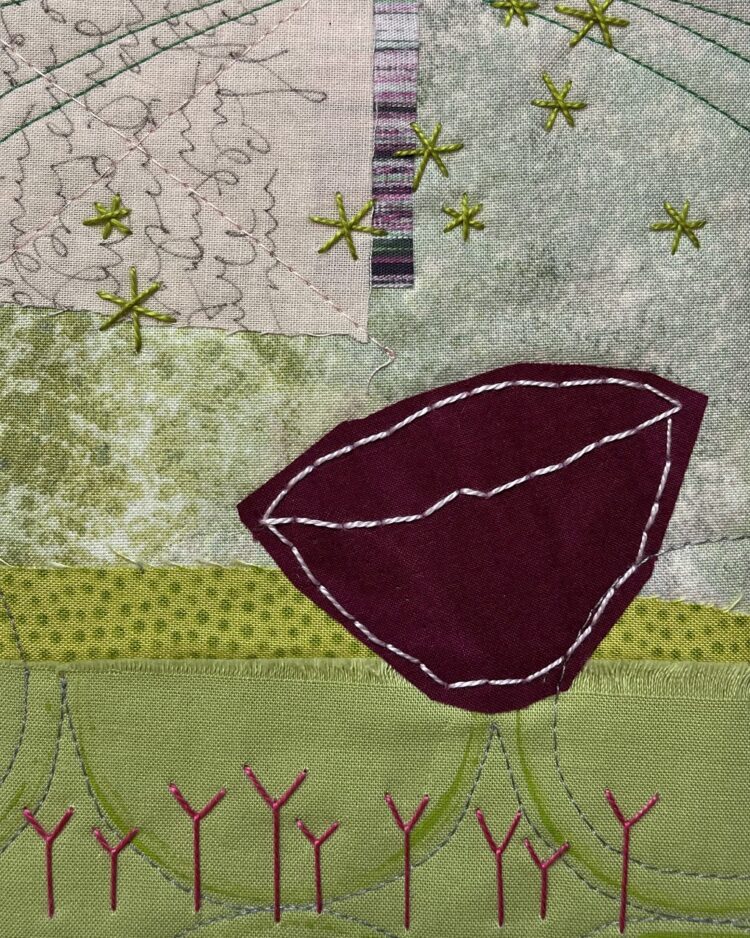
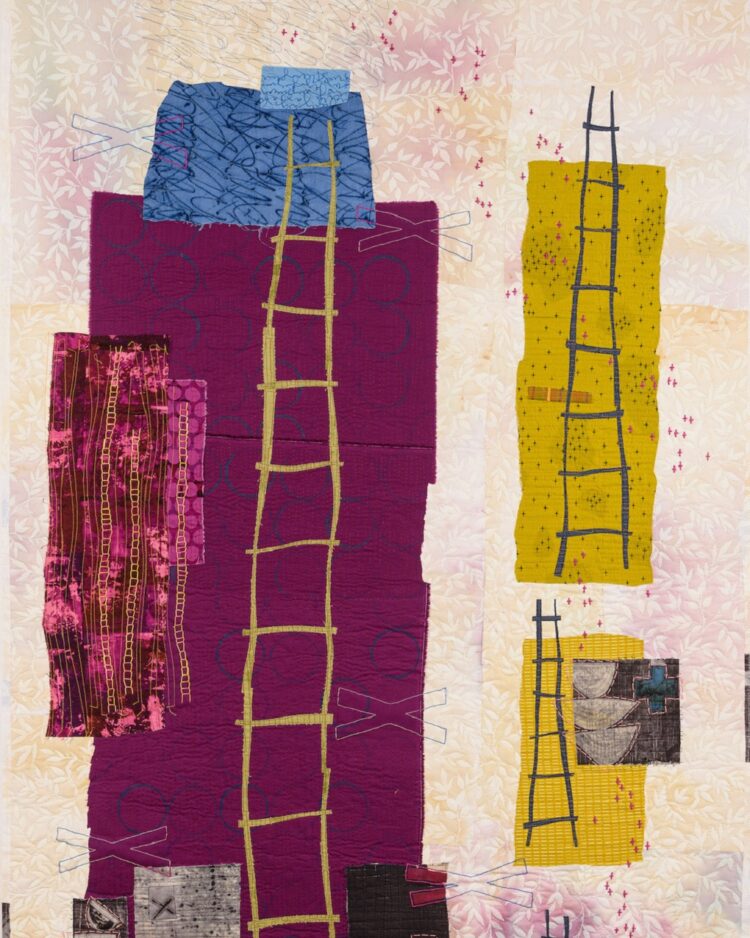
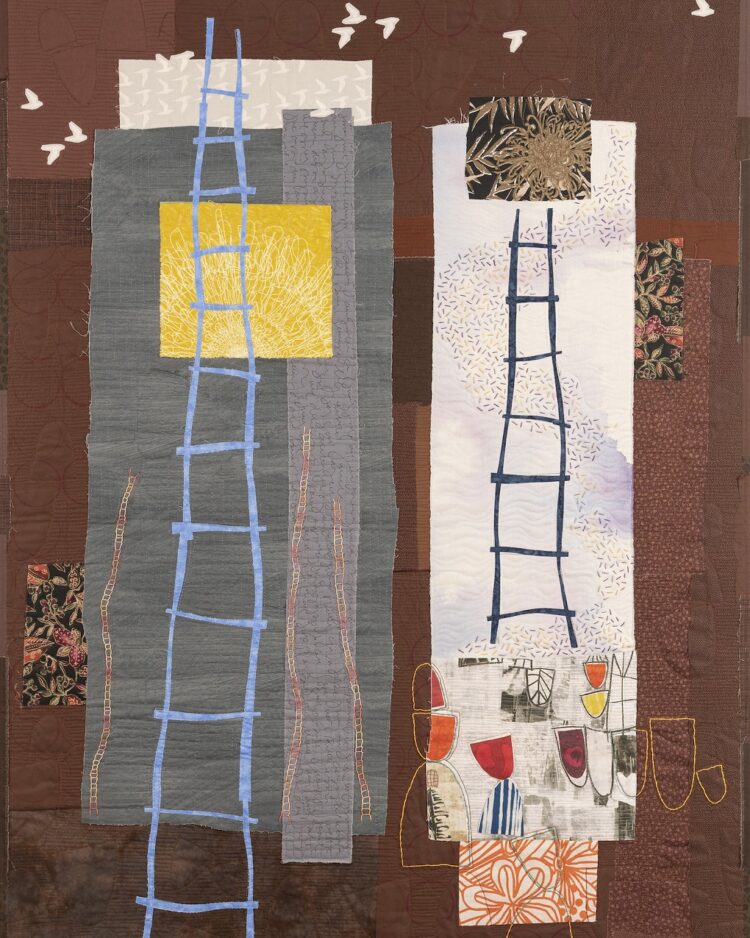

I think the familiarity of seeing people create with cloth and yarn made it possible for me to see myself creating in similar ways.
I remember childhood trips to the fabric store with my mom. I loved perusing bolts of fabric and the astounding variety of prints, patterns, weaves, weights and textures found in cloth. But fibre and needlework are in my blood. My great-grandmother, Mabel, was an accomplished fibre artist. She did weaving, dyeing, embroidery, cross-stitch, needlepoint and more. My father also did needlepoint. My grandmother knit sweaters, and my mother is an excellent seamstress. I am so thankful for the memories of watching all of them work.
Finding my way from kid’s crafts and casual creative projects to becoming an artist has been an adventure that’s been years in the making. The crossover really happened when I began creating exclusively original work using techniques and materials that fit the needs of my vision.
I didn’t go to art school, so the techniques I use most regularly were initially learned in workshops with art quilt teachers. I first learned raw-edged fused appliqué from Melody Johnson. It’s the foundation of how my work is constructed. Over the years, I’ve finessed the details of that process to fit my needs.
In other workshops, I had opportunities to explore surface design techniques and stitching, both by hand and by machine. Usually, these were just one day workshops that might light a fire of curiosity and possibility for me. Sometimes I took workshops where it became clear I wasn’t interested in using what I learned, but that was equally valuable.
From there, I’d look at examples of what other artists were doing with similar techniques and experiment with how they would fit into my own work. I find it very helpful to self critique my work when it’s done, analysing what techniques worked well, which I most enjoyed, and how I might use the same techniques again, or alter them for a different effect.
Learning techniques is just one part of developing as an artist. As I worked toward creating a body of original work, I also needed clarity about things like colour sense, themes, composition, style, and personal voice. I looked at artwork of all kinds and thought about what I liked and didn’t like about a piece, which also informed my own work.
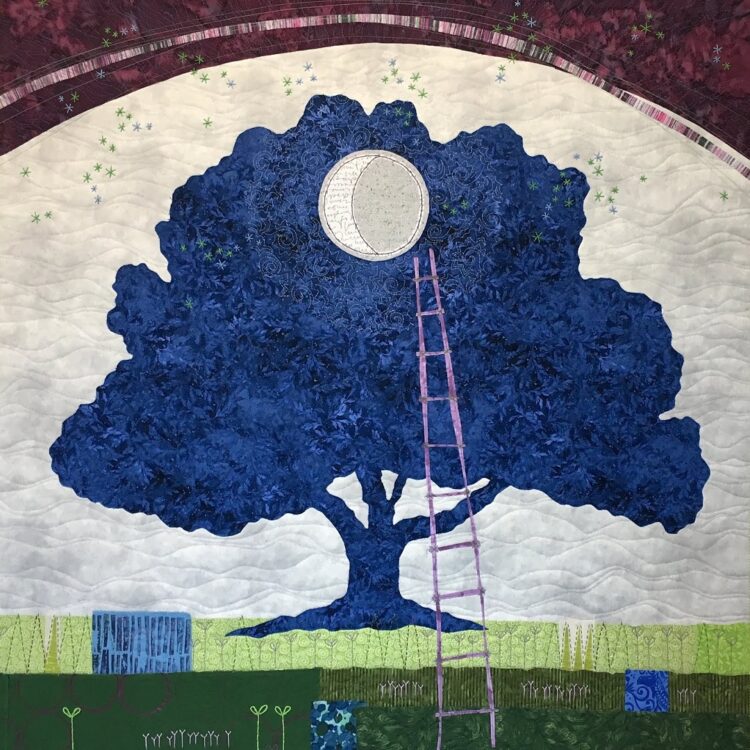
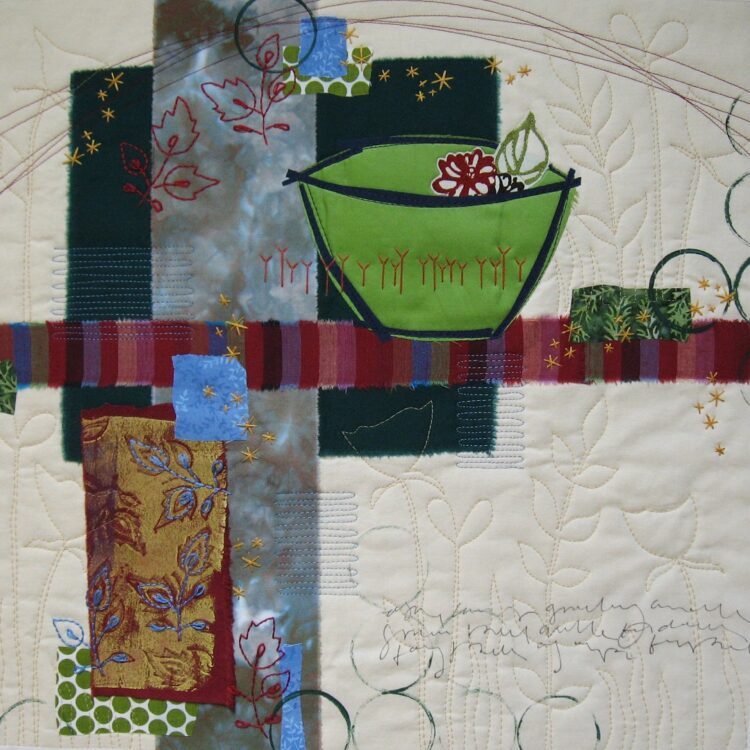
An essential part of my development has been the connections I’ve made with other artists working in the art quilt medium. Studio Art Quilt Associates (SAQA) is an especially rich and diverse organisation, which offers amazing resources to its members, not least of which are the other members themselves. I’ve learned so much from my friends.
In 2016 I was awarded first place in the Miniature Art category at the International Quilt Festival in Houston for my art quilt collage Green Bowl Gathering. It was a small piece (as required for the category), created using raw edge fused appliqué, surface design with found objects and acrylic paint, and improvisational free motion quilting combined with hand embroidery. Many of these techniques were uncommon amongst the hundreds of quilts in the judged exhibition.
Having my work recognised and awarded gave me an immense feeling of validation.
It helped me feel confident in the materials and techniques I was using, and gave me the opportunity to articulate why these artistic choices work for me. I still like to lean into doing things differently.
I continue to share my work in exhibitions that include traditional, modern, art quilts and other textile art because I love the huge variety of work artists create by layering fabric and stitch. I love sharing my art quilt collages, talking about how and why I created them, then offering projects and exercises that give folks an opportunity to explore new ways of creating with fabric, paint and stitch. Hearing people say that they’re inspired, and seeing what they create, is definitely a highlight in my life as an artist.
I am always delighted to spend time with students in workshops. I primarily teach with quilt guilds and quilting events, so I often encounter people who are familiar with traditional quilting techniques, but eager to explore something different.
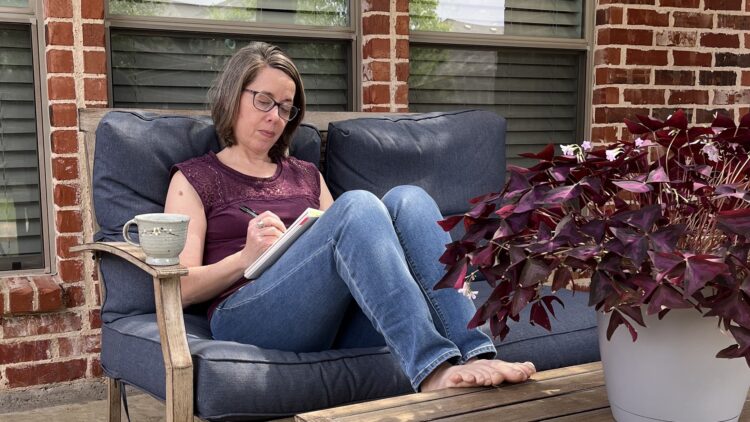
In order to create work that’s meaningful and uniquely hers, Deborah delves deep into her experience. She uses self reflection to find clarity, joy and mastery. To develop your own creative voice, why not experiment with Deborah’s process by noticing:
Deborah Boschert is the author of Art Quilt Collage, A Creative Journey in Fabric, Paint and Stitch. Her work has been shown in gallery and quilt exhibitions all over the world including Art Quilt Elements, Quilts=Art=Quilts and many global exhibitions with Studio Art Quilt Associates. She has appeared on Quilting Arts TV and The Quilt Show. Deborah works from her home studio in Lewisville, Dallas, USA.
Artist website: deborahsstudio.com
Facebook: facebook.com/DeborahBoschertArtist
Instagram: @deborahboschert
Like Deborah, self taught watercolour artist and US art quilter, Peggy Brown stresses the importance of listening to your heart and following your own sensibilities to develop work that is uniquely yours. Discover more about how she develops her award-winning abstract art quilts here.
Recurring symbols and motifs play an essential storytelling role in Deborah’s art quilt collages. We’d love to hear what motifs or symbols appear in your work and why they are important to you. Share an image or tell us more about it in the comments below.